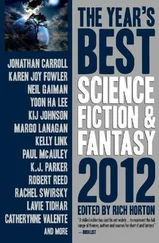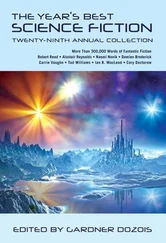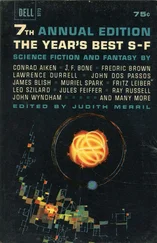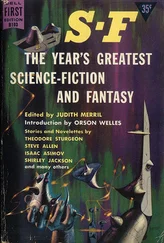Judith Merril - The Year's Greatest Science Fiction & Fantasy 6
Здесь есть возможность читать онлайн «Judith Merril - The Year's Greatest Science Fiction & Fantasy 6» весь текст электронной книги совершенно бесплатно (целиком полную версию без сокращений). В некоторых случаях можно слушать аудио, скачать через торрент в формате fb2 и присутствует краткое содержание. Год выпуска: 1962, Издательство: Dell, Жанр: Фантастика и фэнтези, на английском языке. Описание произведения, (предисловие) а так же отзывы посетителей доступны на портале библиотеки ЛибКат.
- Название:The Year's Greatest Science Fiction & Fantasy 6
- Автор:
- Издательство:Dell
- Жанр:
- Год:1962
- ISBN:нет данных
- Рейтинг книги:3 / 5. Голосов: 1
-
Избранное:Добавить в избранное
- Отзывы:
-
Ваша оценка:
- 60
- 1
- 2
- 3
- 4
- 5
The Year's Greatest Science Fiction & Fantasy 6: краткое содержание, описание и аннотация
Предлагаем к чтению аннотацию, описание, краткое содержание или предисловие (зависит от того, что написал сам автор книги «The Year's Greatest Science Fiction & Fantasy 6»). Если вы не нашли необходимую информацию о книге — напишите в комментариях, мы постараемся отыскать её.
The Year's Greatest Science Fiction & Fantasy 6 — читать онлайн бесплатно полную книгу (весь текст) целиком
Ниже представлен текст книги, разбитый по страницам. Система сохранения места последней прочитанной страницы, позволяет с удобством читать онлайн бесплатно книгу «The Year's Greatest Science Fiction & Fantasy 6», без необходимости каждый раз заново искать на чём Вы остановились. Поставьте закладку, и сможете в любой момент перейти на страницу, на которой закончили чтение.
Интервал:
Закладка:
The announcement of endochronicity, of the fact that a substance existed which dissolved in water 1.12 seconds before the water was added created a stir. You all remember it, I’m sure. And yet, somehow, the impression arose that thiotimoline was a hoax. There was a distinct air of amusement in many of the comments in the learned journals. Private communications reaching me showed a distressing tendency to describe experiments which obviously lacked all scientific validity and which, I could but conclude, were meant as some sort of joke. Perhaps the final proof of the damage this has done is that after twelve years of existence, the American Chronochemical Society can muster an audience of exactly fifteen people to hear this talk.
It has been an expensive joke, gentlemen, one that has cost us our lead in the race for space. For while American researchers have, but with difficulty, obtained grants to continue their investigations of thiotimoline and have been starved into small-scale experiments, while withering under the genial air of disbelief on the part of their colleagues, the Soviet Union has established the town Khruschevsk in the Urals, whose popular nickname of “Tiotimolingrad” will well describe the nature of the activities that go on behind the walls of the modern and well-equipped scientific laboratories that have been established there.
That the Soviet Union has taken thiotimoline seriously and has done something about it is as sure as can be, and yet we remain sunk in complacency. No important political figure has viewed the matter with alarm. If they have said anything at all for publication, it is simply, “What’s thiotimoline?” I intend now to explain to these near-sighted politicos just what thiotimoline means to our space effort.
Thiotimoline research graduated from what we might now call the “classical” stage, to the “modern” with the development of the “telechronic battery” by Anne McLaren and Donald Michie of the University of Edinburgh. If you have read about it anywhere, you can only be clairvoyant, for the popular press and much of the learned press maintained a stubborn silence. In fact, the original paper appeared only in the small though highly respected, Journal of Irreproducible Results, edited by that able gentleman Alexander Kohn. Let me describe the telechronic battery.
A simple endochronometer—with which we are all acquainted—is a device which will automatically deliver water into a small tube containing thiotimoline. The thiotimoline will dissolve 1.12 seconds before the water is delivered.
Imagine the endochronometer so connected with a second similar unit that the solution of the thiotimoline in the first activates the water-delivering pipette of the second. The thiotimoline of the second unit will dissolve 1.12 seconds before that water is delivered, and therefore 2.24 seconds before the water is delivered to the first unit.
An indefinite number of endochronometers can thus be hooked up, the thiotimoline of each of the series dissolving 1.12 seconds before the preceding member. A battery consisting of about 77,000 such units would yield a final sample of thiotimoline which dissolved a full day before the initial quantity of water was delivered.
Such batteries have now been developed both at Edinburgh and in my own laboratories in Boston in extremely compact models, through use of printed circuits and advanced miniaturization. A device of not more than a cubic foot in volume can afford a twenty-four hour endochronic interval. There is strong, if indirect, evidence that the Soviet Union possesses even more sophisticated devices and is turning them out in commercial quantities.
The obvious practical application of the telechronic battery is that of weather prediction. In other words, if the first element of a battery is exposed to the air in such a way that rain, if any, will fall upon it, the final element will dissolve the day before and thus offer a foolproof method of predicting rain—or lack of rain—one day ahead.
I trust you will all see, gentlemen, that the telechronic battery can be used for generalized predictions as well.
Suppose, to take a frivolous example, you were interested in a particular horse race. Suppose you intended to place a wager that a particular horse would win that race. Twenty-four hours in advance of the race, you could make up your mind quite firmly that if the horse were to win the next day, you would, immediately upon receiving the news, add water to the first element of a telechronic battery. If it did not win, you would not.
Having made that decision, you need then but observe the last element. If the thiotimoline in that last element dissolves—followed by a chain of solutions all along the battery at 1.12 second intervals, with which you need not be concerned—you will know that the horse will win beyond doubt. You might even, if you were in a flamboyant mood, allow the solution of the final element to activate a flashing light, a fire gong, a charge of explosive; anything that will unmistakably attract your attention.
You laugh, gentlemen, and yet can this system not be applied, without change, to the launching of a satellite?
Suppose that four hours after launching, an automatic device on board the satellite telemeters a signal to the launching base. Suppose, next, that this radio signal is designed to activate the first element of a telechronic battery.
Do you see the consequences? The sending of the signal four hours after launching can only mean that the satellite is safely in orbit. If it were not, it would have plunged to destruction before the four hours had elapsed. If then, the final element of the telechronic battery dissolves today, we can be certain that there will be a successful launching tomorrow and all may proceed.
If the final element does not dissolve, the launching will not be successful and there must, therefore, be something wrong with the satellite assembly. A team of technicians will begin checking the device and at the moment when the defective item is corrected, the telechronic battery will operate. The launching will then be scheduled in the full expectation of success.
Do you still laugh, gentlemen?
Is this not the only feasible explanation for the consistent Soviet successes as compared with our own very spotty record? It is customary, of course, to attribute the appearance of unfailing success of Soviet launchings to the fact that they have been deliberately hiding many failures, but does this stand up? Have they not, with remarkable consistency, managed to score successes at such time as would most profit themselves?
Sputnik I went up within a month of the hundredth birthday of Tsiolkovsky, the soviet rocket pioneer. Sputnik II went up to celebrate the fortieth anniversary of the Russian Revolution. Lunik II went up just before Khrushchev’s visit to the United States. Lunik III went up on the second anniversary of Sputnik I.
Coincidence? Or did they simply have the foreknowledge of their telechronic batteries? Have they tested a number of possible rocket assemblies and selected that one for which success was forecast? How else can one explain that the United States has not yet succeeded in launching any of their many rockets on some significant day?
Nor, remember, do the Soviets invariably hold their announcements back until they are certain they have achieved success, as some have suggested. In at least one case, they announced an achievement in advance.
When Lunik III was on its way to circle the Moon, the Soviet scientists confidently announced it would take pictures of the hidden side of the Moon as it progressed round that body in its orbit. As far as the orbit of Lunik III was concerned, they were safe. From its motion and from the positions of Earth, Moon and Lunik, the orbit of Lunik III could be calculated with absolute precision.
Читать дальшеИнтервал:
Закладка:
Похожие книги на «The Year's Greatest Science Fiction & Fantasy 6»
Представляем Вашему вниманию похожие книги на «The Year's Greatest Science Fiction & Fantasy 6» списком для выбора. Мы отобрали схожую по названию и смыслу литературу в надежде предоставить читателям больше вариантов отыскать новые, интересные, ещё непрочитанные произведения.
Обсуждение, отзывы о книге «The Year's Greatest Science Fiction & Fantasy 6» и просто собственные мнения читателей. Оставьте ваши комментарии, напишите, что Вы думаете о произведении, его смысле или главных героях. Укажите что конкретно понравилось, а что нет, и почему Вы так считаете.












